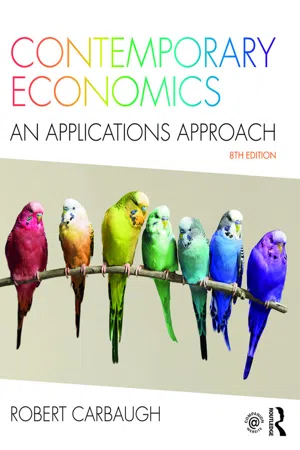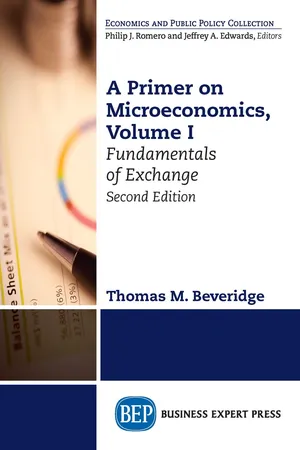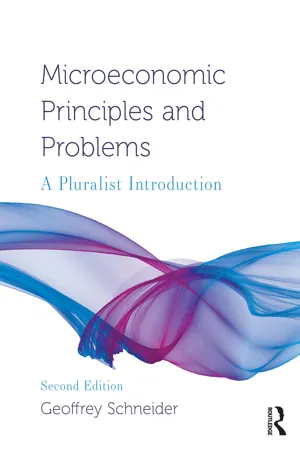Economics
Midpoint Method
The Midpoint Method is a technique used to calculate the price elasticity of demand. It involves measuring the percentage change in quantity demanded and the percentage change in price between two points on a demand curve. The midpoint formula is considered more accurate than the traditional percentage change formula because it avoids the bias that can result from choosing a base point.
Written by Perlego with AI-assistance
Related key terms
4 Key excerpts on "Midpoint Method"
- Available until 20 Jul |Learn more
Contemporary Economics
An Applications Approach
- Robert Carbaugh(Author)
- 2016(Publication Date)
- Routledge(Publisher)
price elasticity of demand measures how responsive, or sensitive, buyers are to a change in price. The price elasticity of demand looks at the percentage change in quantity demanded relative to the percentage change in price. The elasticity formula isE d=Percentage change in quantity demanded Percentage change in pricewhere Ed is the elasticity coefficient.11 The midpoint formula is used to calculate the elasticity between two points on a demand curve (or supply curve). This formula uses the averages of the two quantities and the two prices under consideration as reference points. According to the midpoint formula, the percentage change in quantity equals the change in the quantity divided by the average of the two quantities; the percentage change in price equals the change in price divided by the average of the two prices. Therefore, the price elasticity of demand equals:Suppose that attendance at the Lakers’ games decreases by 10 percent when the price of tickets increases by 5 percent. Thus, the price elasticity of demand is 2:E d=Change in quantity÷Sum of quantities / 2Change in priceSum of prices / 2The value of the elasticity coefficient, 2, suggests that game attendance changes 2 percent for each 1-percent change in the price of a ticket.E d=10 percent change in quantity demanded 5 percent change in price= 2You may have noticed that instead of 2, the value of Ed should actually be −2. This is because price and quantity demanded are inversely related according to the law of demand. In our example, the increase in ticket prices causes the numerator in the formula to be positive (+10 percent), while the decrease in game attendance causes the denominator to be negative (−5 percent). As a result, Ed - eBook - ePub
Economics of Tourism and Hospitality
A Micro Approach
- Yong Chen(Author)
- 2021(Publication Date)
- Routledge(Publisher)
The responsiveness of demand can be assessed using marginal demand and demand elasticity. Marginal demand is the change in the quantity demanded of a good divided by the change in a demand determinant. Elasticity of demand is the percentage change in the quantity demanded divided by the percentage change in the demand determinant.Elasticity of demand is a unit-free measure of demand responsiveness, because the calculation of percentage changes cancels out measurement units. Elasticity of demand can be calculated in three ways: arc elasticity, midpoint elasticity, and point elasticity.Elasticity of demand with respect to a demand determinant suggests the nature of the relationship between the two variables indicated by the sign of elasticity and the size of the effect of the demand determinant indicated by the absolute value of elasticity. When comparing the size of elasticity, we ignore the sign of elasticity.When the percentage change in demand is greater than the percentage change in the demand determinant, elasticity is greater than 1, and hence demand is elastic. When percentage change in demand is smaller than the percentage change in the demand determinant, elasticity is smaller than 1, and hence demand is inelastic. When the two percentage changes are equal, demand is unit elastic.The price elasticity of demand is the percentage change in quantity demanded divided by the percentage change in the price of a good. The demand for tourism products and services in general is elastic.The income elasticity of demand is the percentage change in quantity demanded divided by the percentage change in consumer income. Using income elasticity we can distinguish between inferior goods and normal goods, and further divide normal goods into necessities and luxuries. Tourism products and services in general are luxuries.The cross-price elasticity of demand is the percentage change in the quantity demanded of a good divided by the percentage change in the price of a related good. Using cross-price elasticity we can assess whether the two goods are substitutes or complements. - eBook - ePub
A Primer on Microeconomics, Second Edition, Volume I
Fundamentals of Exchange
- Thomas M. Beveridge(Author)
- 2018(Publication Date)
- Business Expert Press(Publisher)
Slope ≠ Elasticity. From what has been said so far, and from the previous figures, it would be tempting to infer that the steeper the demand curve, the smaller the price elasticity of demand, and therefore, that the slope of the demand reveals its elasticity. However, this is incorrect.Consider the following demand schedule for apples and its associated demand curve (Table 4.1 ).Note that as price rises from $5 to $6, total revenue decreases from $20 to $12. Using the total revenue test, the decrease in total revenue as a consequence of the price increase is enough to tell us that demand is elastic in that price range.Challenge : Use the Total Revenue Test to classify elasticity in the price ranges $4 to $5, $3 to $4, $2 to $3, and $1 to $2. (The results are elastic, unit elastic, inelastic, and inelastic, respectively.) In each of the examples, price increased. Does it make any difference to your results if, instead, price decreases? (It doesn’t!)The demand curve in Figure 4.3 graphs as a straight line—its slope is constant—but we have shown that the elasticity is not constant. Using the Total Revenue Test, given a straight line demand curve we can see that at high prices, demand is elastic whereas, at low prices, demand is inelastic and that there is an inelastic area in the middle of the range. Accordingly, although elasticity certainly is related to the slope of the demand curve, it is distinct from it.The Midpoint FormulaThe total revenue test allows us to categorize elasticity in a price range as “elastic,” “inelastic,” or “unit elastic,” but it does not provide precise elasticity values. The “intuitive” formula that we’ve already seen can be used if the percentage changes in price and quantity are known, but if only the prices and quantities are known, then the best approach is to use the “midpoint” formula.Given that price changes from P1 to P2 , the intent behind the midpoint formula is to derive the average of the initial price (P1 ) and the final price (P2 ) to get (P2 + P1 )/2, and similarly, to derive the average of the initial quantity (Q1 ) and the final quantity (Q2 ) to get (Q2 + Q1 )/2. The change in price is (P2 – P1 ) while the change in quantity is (Q2 – Q1 ). To interpret: The formula is comparing the change in quantity (Q2 – Q1 ) to an “average” or midpoint quantity, (Q2 + Q1 )/2, and similarly, comparing the change in price (P2 – P1 ) to an “average” or midpoint price, (P2 + P1 - eBook - ePub
Microeconomic Principles and Problems
A Pluralist Introduction
- Geoffrey Schneider(Author)
- 2024(Publication Date)
- Routledge(Publisher)
.- Peter Cohen, Robert Hahn, Jonathan Hall, Steven Levitt, and Robert Metcalfe, “Using Big Data to Estimate Consumer Surplus: The Case of Uber,” National Bureau of Economic Research Working Paper 22627, September 2016.
- Most research indicates that real-world demand curves are curved slightly, like the unit elastic demand curve, and they can be either steeper or flatter than the unit elastic demand curve. However, in terms of making general predictions regarding how changes in supply and demand are likely to affect equilibrium price and equilibrium quantity, using linear supply and demand curves will suffice.
Passage contains an image
11 Consumer and supplier behavior
The complexities of market analysisDOI: 10.4324/9781003368441-14In the previous two chapters, we worked through the supply and demand model in detail, showing how the model can be used to analyze markets and to predict how a variety of determinants will affect equilibrium prices and quantities in various markets. In this chapter we turn to some of the aspects of markets that are harder to quantify and model—the often less rational and more impulsive and culturally determined behavior of consumers, and the complex decisions made by sellers in complex firms facing issues related to creative destruction and market power.The first section of this chapter focuses on consumers and how they think in complex situations. Recall that in mainstream economic analysis, consumers are viewed as rational, self-interested, calculating, and fully informed decision makers. However, there are circumstances in which we need to refine that model of human behavior. Utilizing Veblen’s institutionalist approach to economic behavior, along with modern behavioral economics that builds on many of Veblen’s ideas, we will explore some of the complexities of consumer behavior.
Learn about this page
Index pages curate the most relevant extracts from our library of academic textbooks. They’ve been created using an in-house natural language model (NLM), each adding context and meaning to key research topics.



